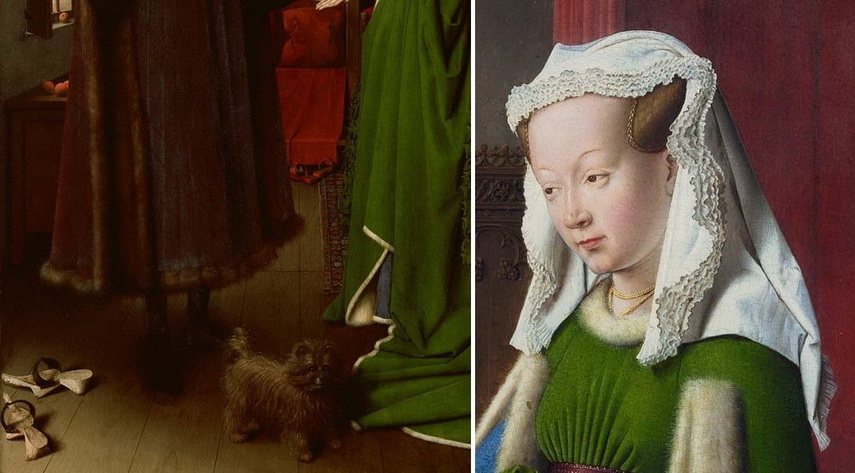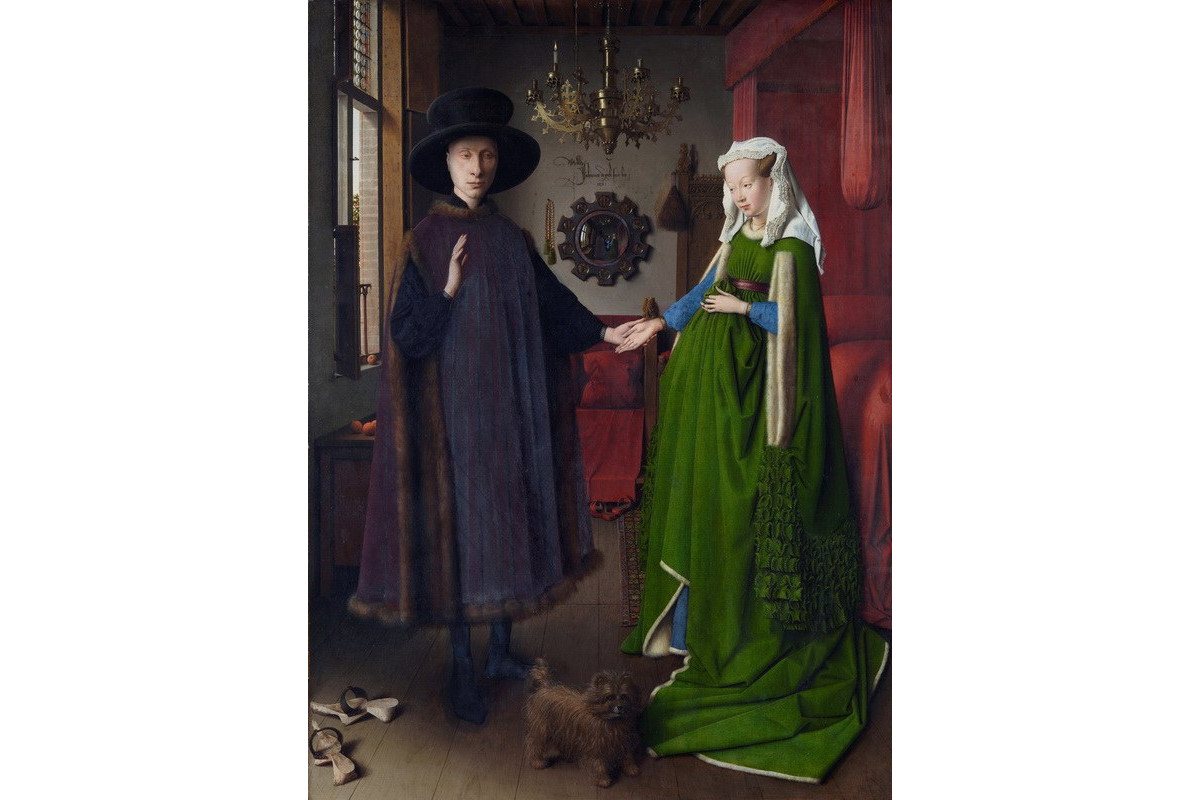[ad_1]
The Western art history is saturated with outstanding masterpieces made throughout the centuries, and one of the authentic and enigmatic paintings is The Arnolfini Portrait by Jan van Eyck. It is a 82-per-60 cm oil painting made in 1434 on oak panel and it features a double portrait of the Italian merchant Giovanni di Nicolao Arnolfini and his wife, presumably in their Flemish home.
This outstanding Renaissance work is also known as The Arnolfini Marriage or The Arnolfini Wedding due to an apparent indication that the couple is represented in the moment after taking vows. It is the oldest famous painting made on a panel in oils and was purchased in 1842 by the National Gallery in London.
The first book in which the identity of the couple was revealed was the one by Crowe and Cavalcaselle published in 1857, while four years later James Weale confirmed this analysis in his book and identified Giovanni’s wife as Jeanne (or Giovanna) Cenam. Those conclusions were widely accepted until 1997 when yet another analysis determined they were married in 1447, thirteen years after the date on the painting and six years after van Eyck’s death.
The speculation went even further: the scholars believe that the male figure represented is either Giovanni di Arrigo or his cousin, Giovanni di Nicolao Arnolfini and the woman is one of their spouses – meaning that this is either the first wife of Giovanni di Arrigo, or the second wife of Giovanni di Nicolao, or perhaps Giovanni di Nicolao’s first wife Costanza Trenta, who passed away in 1433 while giving birth. If this is the case, the portrait would be slightly eerie, because it features one living and one dead person.

The Arnolfini Portrait Composition
The newlyweds in The Arnolfini Portrait are depicted in a reception room, which was fashionable in France during that time. The cherry tree blossom which lurks from the window indicates that the scene was taken during early summer. The Arnolfinis are wearing elaborate outfits, quite expensive at the time and that tells much about their social status; both their outer garments are lined with fur despite the season; he is wearing a hat of plaited straw dyed black, as often worn in the summer at the time, while her dress has elaborate dagging (cloth folded and sewn together, then cut and decorated) on the sleeves, and a long train; both of them are adorned with plain jewelry as well.
The room is furnished according to the latest fashion – an impressive brass chandelier, the bed, and other objects. In the back of the composition is the convex mirror in a wooden frame. Perhaps the only thing missing is a fireplace. The composition also includes lavish bed-hangings and the carvings on the chair and bench against the back wall, as well as a small Oriental carpet on the floor by the bed. One can also spot oranges, another symbol of The Arnolfini wealth, since they were very expensive in Burgundy.
The reflection in the mirror shows two figures that the couple is facing, and the second figure wearing a red turban is probably the artist himself, although he does not seem to be painting. The painting also features a dog of the breed now known as the Brussels griffon.
Above the mirror, there is a sign of the artist Johannes de Eyck fuit hic 1434 or Jan van Eyck was here 1434. It looks like the inscription was painted in large letters on the wall, which was done with proverbs and other phrases at this period.

The Symbolism of This Jan van Eyck Painting
The belief that the couple was already married was supported by the woman’s headdress since the non-married woman would have her hair down. The poses of two figures reveal traditional gender roles – the woman stands near the bed and symbolically marks her role as the caretaker of the house, while Giovanni stands next to the open window underlining his role in the outside world. However, the woman looks directly at her husband, reflecting her equality and the manners typical for the Burgundian civil society and in general middle class. Furthermore, their mutual gesture of joined hands reveals the act of martial oath.
Although the woman seems to be pregnant, the scholars suggest that such attire was fashionable then. Namely, Arnolfini was a cloth merchant, meaning that fashion was very important to him, and the more clothes a person wore, the wealthier they were considered to be. Such imagery is also related to the way the Virgin Mary and other female saints were depicted during the early Renaissance period, as well as with the couple’s desire to be shown as prone to fertility and progeny. That is further supported by the image of a carved female saint as an ornament on the bedpost, probably of Saint Margaret, patron saint of pregnancy and childbirth.
The frame of the convex mirror features the small medallions with scenes from the Passion of Christ aimed to represent God’s promise of salvation for the figures reflected on the mirror’s surface. Interestingly so, all the scenes on the wife’s side belong to the cycle of Christ’s death and resurrection, while those on the husband’s side belong to the cycle of Christ’s life.
In the lower central part of the painting is the depiction of a dog alluding to loyalty and fidelity, and can be perceived as an emblem of lust underlining the couple’s desire to have a child. The dog a gift from husband to wife, a lap dog owned by many courtly women, which is yet another signifier of the Arnolfini wealth.
The woman’s green dress symbolizes hope (of becoming a mother), while the white headpiece signifies purity or rather her marital status. The curtains behind the Arnolfini are opened which suggests the marital duty e.g. act of intercourse.
The proposition that this is indeed a memorial portrait is supported by the fact that the single candle in the chandelier is lit in full daylight, alluding to the presence of the Holy Ghost on Giovanni’s side, and is in contrast with the burn out candle of the side of his wife indicating the life/death opposition.
The painting also features fruits such as cherries on the tree outside the window which symbolize love and the mentioned oranges which symbolize the purity and innocence present in the Garden of Eden before the Fall of Man.
Jan van Eyck’s Arnolfini Portrait
The Historical Significance of The Arnolfini Portrait
According to historical records, in 1516 The Arnolfini Portrait came into the possession of the Spanish career courtier of the Habsburgs Don Diego de Guevara who gave it away as a gift to Margaret of Austria. Her niece, Mary of Hungary, inherited the painting in 1530, and in 1556 she moved to Spain, and after her death in 1558 the painting went to Philip II of Spain. A century later, in 1700, the work belonged to the inventory of Carlos II and subsequently was in the possession of a Scottish soldier Colonel James Hay, who was present in the Battle of Vitoria in Spain in 1813, where a large coach loaded by the army of King Joseph Bonaparte with artworks from the Spanish royal collections was first plundered by British troops. Finally, Hay gave the painting to the Prince Regent, later George IV of England, who had it on approval for two years before returning it in 1818. Hay finally arranged for the portrait to be included in a public exhibition in 1841, and a year later it was purchased by the National Gallery for £600.
Throughout the 20th-century, various art historians argued about the many aspects of the painting, and despite the fact certain conclusions seem stable and supported by other historical facts, the Arnolfini portrait still represents a mystery. Whatever van Eyck’s intention behind the symbolical content was, the painting was truly innovative for its time, due to the use of light, the depiction of fifteenth-century interior and the fact this was practically the first genre painting; it still is considered as a revolutionary masterpiece which tells much about the 15th century society and the Western paradigm of the concepts of marriage and family framed by religious beliefs.
Editors’ Tip: Girl in a Green Gown: The History and Mystery of the Arnolfini Portrait
The Arnolfini marriage portrait, as it is generally if perhaps inaccurately known, painted by Flemish artist Jan van Eyck, signed and dated 1434, has long been one of the most popular and enigmatic paintings of its time. Of modest size, a little less than three feet high, it is one of the oldest surviving panel pictures to be painted in oils rather than tempera. It is also regarded as the first work of art which simultaneously celebrates both middle-class comfort and monogamous marriage. Not surprisingly, very little is known for certain about who the sitters are. The common assumption is that it is a portrait commemorating the wedding of Giovanni Arnolfini, an Italian merchant, and his probably pregnant wife, who are seen at their home in Bruges.
Featured image: Jan van Eyck – The Arnolfini Portrait, 1434. Oil on oak panel of 3 vertical boards; 82.2 cm × 60 cm (32.4 in × 23.6 in); panel 84.5 cm × 62.5 cm (33.3 in × 24.6 in). National Gallery, London. All images creative commons
[ad_2]
Source link

